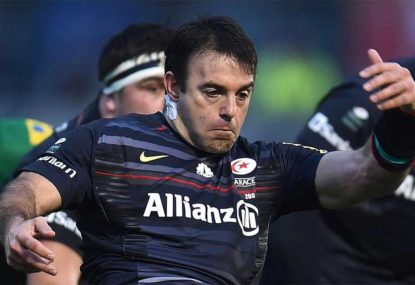Super Rugby shows that the Bledisloe Cup isn't going anywhere - one selection could give the Wallabies hope
By my count, the Brumbies have played three teams of consequence this season. The first two - the Chiefs and Blues - thrashed them…

Concussion is the big issue in contact sports right now. More is being understood about the long-term impacts of on-field head injuries, and administrative bodies are starting to realise more about what happens to our brains when we play the game.
So, to find out exactly what kind of stress players’ brains are under, English rugby union side Saracens have fitted their players with stick-on sensors.
Saracens CEO Ed Griffiths said the move was to assess what a player goes through during a game in the hope to avoid medium and long-term injuries.
“I don’t want to be visiting our players in 20 to 25 years’ time to find them suffering from dementia,” he said.
“We want to find out”.
The sensors, as could be expected, are pretty tough, and according to the players they don’t get in the way of the game too much. A small taped-over electronic device that sits behind the ear, they look a little like that kid at the Coles checkout who had to tape over his eyebrow ring so that he doesn’t offend the nannas.
class=”twitter-tweet” lang=”en”>Club Statement: @Saracens players wore impact sensors as club launches 'concussion' programme http://t.co/e8BZ4jPs1e pic.twitter.com/UcwlnI2Rox
— Saracens Rugby Club (@Saracens) January 4, 2015
Tests on American football players’ brains have showed worrying indications of chronic traumatic encephalopathy (CTE), a neurodegenerative condition that appears all too common in ex-footballers.
Indeed, the condition is so prevalent in the sliced up brains of ex-players, some have called it ‘football’s industrial disease’.
In recent years the NFL have taken steps to tackle the concussion issue, due mainly to the prospect of multi-million dollar lawsuits from ex-players who have contracted brain injuries – most likely as a result of frequent helmet clashes.
The New York Times have reported that brain injuries are expected to affect one in three NFL players, meaning the potential payout is huge. Vice News notes that the NFL’s compensation package to former players with brain injuries is to be in the vicinity of $US1 billion, so preventative measures are not just good for player welfare, they’re obviously a lot cheaper.
While the NFL may be trying to wrangle its way out of paying injured players, prevention is better than cure and on-field sensors may be able to shed some light on the issue. Rule changes or adaptations in equipment would be the next logical step.
Players have played with concussion sensors on helmets and in mouth-guards for a while now, and sensors are expected to be rolled out across the NFL before the end of 2015.
Closer to home, the NRL has banned the shoulder charge as a means of enhancing player safety, principally by avoiding the risk of concussion. There are also moves towards having independent doctors on the sidelines to ensure players stay off the field should they be at a real risk. The ARU have indicated that Saracens’ use of the technology has “caught their eye”.
Even football – which as my uncle will remind you is less of a contact sport than the Boxing Day sales – have been researching long-term head injuries due to players heading the ball.
It has become clear that, for a concussion (brain hitting skull) to occur, a helmeted athlete does not need to collide with another helmeted athlete at full speed. Even heading in a corner could injure the brain in the long term.
Many rugby players are already wired up with GPS devices to record their every move, and other sports have miked up players to provide in-game, on-the-field commentary. If players are already wired up like a tag-and-release barra, installing a concussion monitor probably won’t be too problematic.
While it’s early days yet – Saracens have indicated that the technology is purely experimental at this stage – there is the potential that the sensors will provide not only long-term data on player injury, but useful short-term information. A concussion grading could be installed, meaning no amount of Tommy Raudonikis-style sideline pleading will get a player back on the park should the doctor realise a concussion is of a certain severity.
It would also take the pressure off the individual players to get back out there, as the choice would no longer be in their hands.
No more ‘teaspoon of concrete’ or hardening the f**k up. Computer says no.
Your 55-year-old brain will thank you.
This post originally featured on Techly.